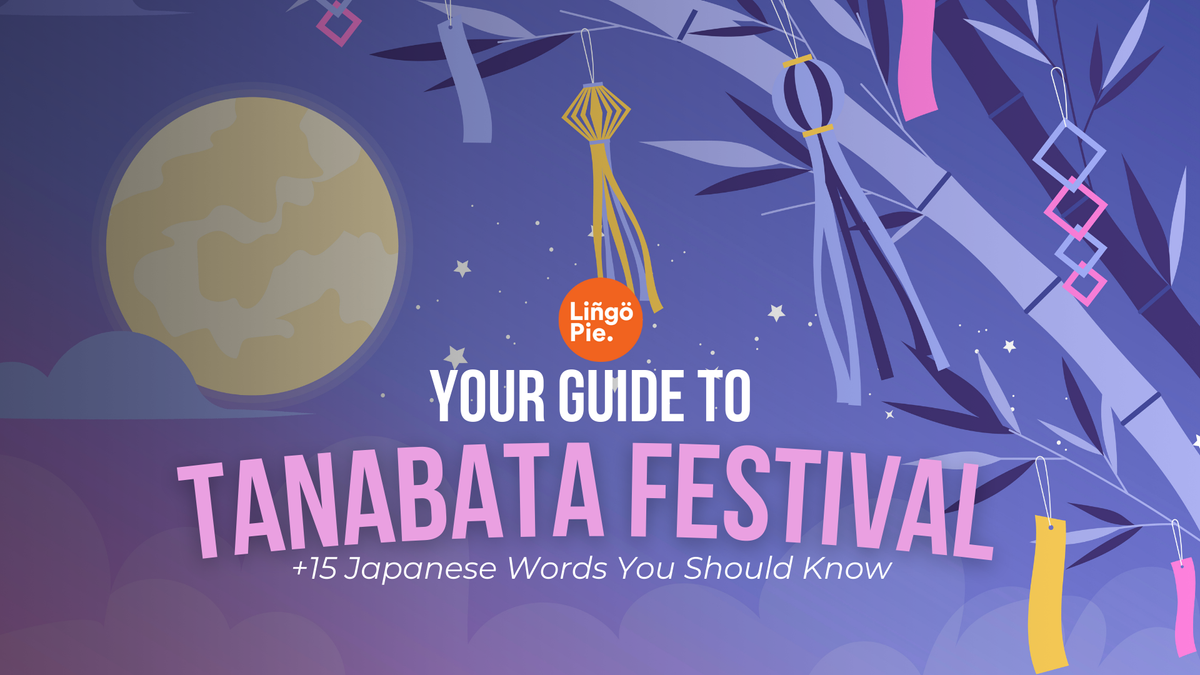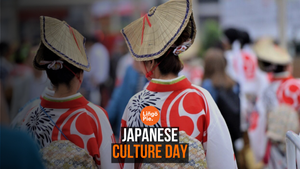Imagine a magical festival dedicated to a legendary love tale of star-crossed lovers. The streets are bursting with vibrant decorations, lively parades, and delicious food. During this festival, people write their wishes on colorful paper strips and hang them on bamboo branches, hoping for their dreams to come true.
Yes, I'm talking about the Tanabata Festival in Japan! It is a must-see event that captures the heart and spirit of Japanese culture. So, read this guide to learn everything about the Tanabata Festival and how to enjoy it!
- 7+ Unexpected Places You’ll Hear Japanese
- How To Use Mo (も) Particle In Japanese Grammar [Guide]
- 70+ Japanese Phrases Every Fan Heard At Least Once

What Is The Tanabata Festival?
Tanabata (たなばた or 七夕), meaning "Evening of the Seventh," is also known as the Star Festival (星祭り, Hoshimatsuri). The name itself tells a story: 七夕 uses the kanji for "seven" (七) and "evening" (夕), perfectly capturing the festival's timing on the seventh day of the seventh month.
While the official date is July 7th, many regions still follow the traditional lunar calendar, celebrating in August instead. This calendar difference actually gives you more opportunities to experience Tanabata if you're planning a trip to Japan.
History Of Tanabata
Tanabata comes from an old Chinese legend about Orihime, a weaving princess, and Hikoboshi, a cowherd, who fell in love but were separated by the Milky Way. They are allowed to meet just once a year on the seventh day of the seventh month. This love story is the heart of the festival and why people write wishes for things they hope will come true.
The festival came to Japan during the Nara period as part of the Chinese Qixi customs. Over time, it blended with local traditions like Obon and spread beyond the royal court to towns and villages. By the Edo period, Tanabata had become popular with people all over Japan. Today, it is celebrated in many different ways across the country.
- Nara Period (710-794 AD): Introduction of Tanabata from China.
- Heian Period (794-1185 AD): Tanabata becomes popular among the aristocracy.
- Edo Period (1603-1868 AD): Festival customs spread to the general populace.
- Modern Era: Tanabata becomes a nationwide celebration with various regional variations.
What Are The Traditions Of The Tanabata Festival?
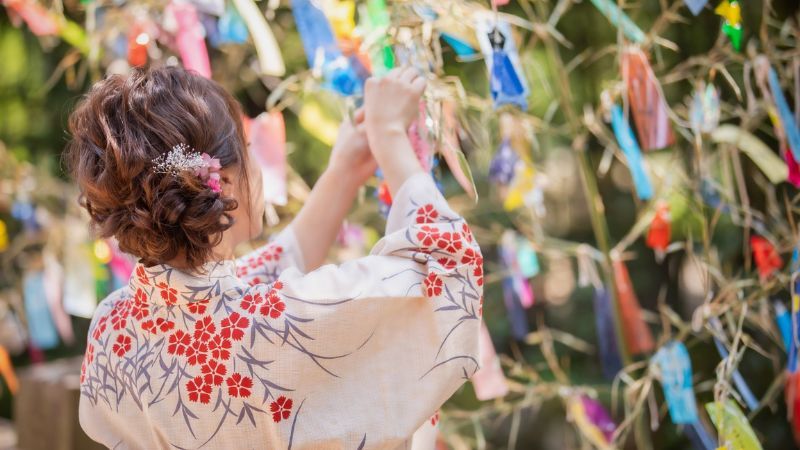
1. Writing Wishes on Tanzaku (Colorful Strips of Paper)
One of the most beloved customs of Tanabata is writing wishes on tanzaku, colorful strips of paper. People inscribe their hopes and dreams, ranging from personal aspirations to prayers for health and happiness.
Wishes are written using a brush and ink, reflecting traditional calligraphy practices. The act of writing a wish is seen as a way to focus on one’s desires and send them to the heavens, hoping they will be granted.
Common Wishes and Their Meanings:
- Academic success for students.
- Prosperity and good health for families.
- Success in love and relationships.
- Fulfillment of personal goals and ambitions.
2. Decorating Bamboo Branches with Tanzaku and Other Ornaments
Decorating bamboo branches is a central part of Tanabata festivities. These branches, adorned with tanzaku and various ornaments, are placed outside homes, schools, and public spaces.
The decorations represent different prayers and wishes, each carrying its own meaning. For example, bamboo is chosen for its straight growth and resilience, symbolizing strength and flexibility.
Types of Ornaments and Their Meanings:
- Origami Cranes: Prayers for health and long life.
- Paper Lanterns: Light and guidance.
- Streamers: Represent the weaving threads of Orihime, symbolizing her work as a weaver.
- Paper Nets: Symbolize good fishing harvests and good luck in business.
- Purse-shaped Ornaments: Prayers for wealth and prosperity.
3. Traditional Tanabata Songs and Dances
Music and dance play an integral role in the Tanabata celebrations, adding to the festive atmosphere.
- Tanabata Ondo: A traditional dance performed at many Tanabata festivals. Participants dance in a circle, wearing yukatas (summer kimonos), creating a sense of community and shared joy.
- Children's Songs: Often, children sing specific Tanabata songs that recount the legend of Orihime and Hikoboshi, helping to pass down the story and traditions to younger generations.
Read Also:
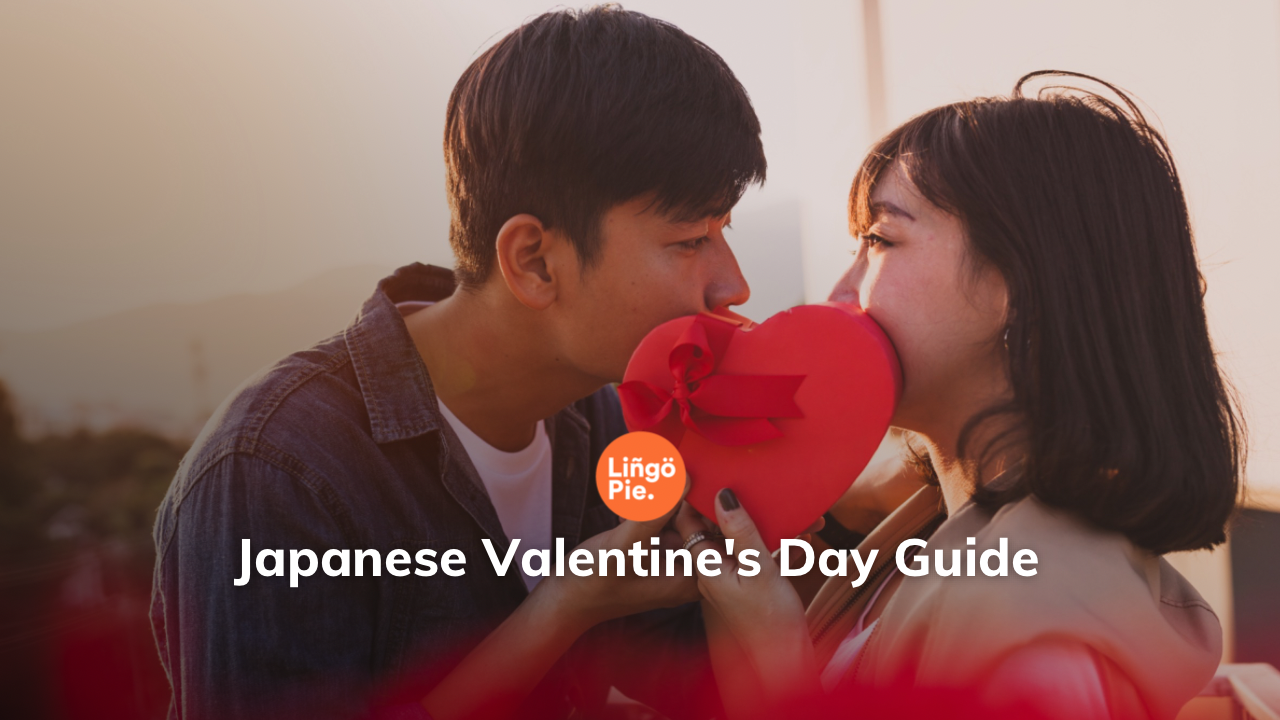

Where Do Major Tanabata Festivals Take Place In Japan?
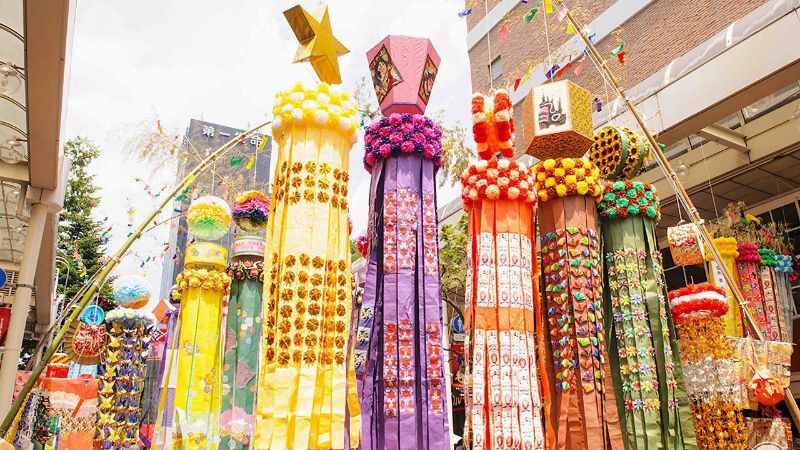
Traditionally, Tanabata is celebrated on July 7th, but many places hold their festivals in early August to align with the old lunar calendar and summer holidays. This means you can catch Tanabata festivities across Japan throughout July and August.
Some of the most famous Tanabata celebrations include:
- Sendai Tanabata Matsuri (Miyagi Prefecture): Japan’s largest, with massive, intricate paper decorations hanging from shopping arcades.
- Shonan Hiratsuka Tanabata Festival (Kanagawa Prefecture): Known for towering bamboo displays, parades, and street performances.
- Kyoto Tanabata: Features romantic illuminated displays along rivers and historic streets.
- Asagaya Tanabata (Tokyo): Local shops create colorful handmade decorations, giving this neighborhood festival a charming community feel.
What To Expect At The Tanabata Festival?
Participate in Wish-Writing and Decorations
Visitors to the Tanabata Festival can immerse themselves in the tradition of wish-writing by creating their own tanzaku (colorful paper strips). Many festival venues provide designated areas where participants can write their wishes, using brushes and ink to inscribe their hopes and dreams.
After writing their wishes, visitors can then hang their tanzaku on bamboo branches adorned with other colorful decorations, contributing to the festive ambiance.
Explore Traditional Crafts and Performances
The Tanabata Festival offers opportunities for visitors to explore and appreciate traditional Japanese crafts and performances. Throughout the festival grounds, there are often workshops and live demonstrations where artisans showcase their skills in origami, paper crafts, and weaving.
Visitors can also observe these artisans at work, learn about the techniques involved, and even try their hand at creating their own traditional crafts under expert guidance.
Taste Local Cuisine
One of the highlights of any Japanese festival is the diverse array of local cuisine available at food stalls and vendors scattered throughout the festival area. Visitors can indulge in a variety of must-try foods, including:
- Takoyaki: Savory octopus balls topped with takoyaki sauce, mayonnaise, and bonito flakes.
- Yakitori: Grilled skewers of tender chicken, seasoned with salt or a sweet soy-based sauce.
- Kakigori: Refreshing shaved ice dessert flavored with syrup, often topped with condensed milk or sweetened azuki beans.
Tips For Foreign Visitors
Planning ahead will help you really enjoy the festival. Big Tanabata celebrations like Sendai or Hiratsuka can get very crowded, so be prepared and know what to bring. Here are some useful ideas:
• Book your hotel and transportation well in advance since nearby places fill up quickly
• Bring enough cash because many festival stalls do not accept cards
• Carry a small folding fan and towel to stay cool in the summer heat
• Wear comfortable shoes because you will do a lot of walking
• Pack a small bag for your trash since public bins may be limited
Once you are there, join the fun. Write your wish, taste different festival treats, and talk with locals if you can. Arrive early if you want a good spot for parades or fireworks, and always check the weather so you can dress comfortably.
Read Also:
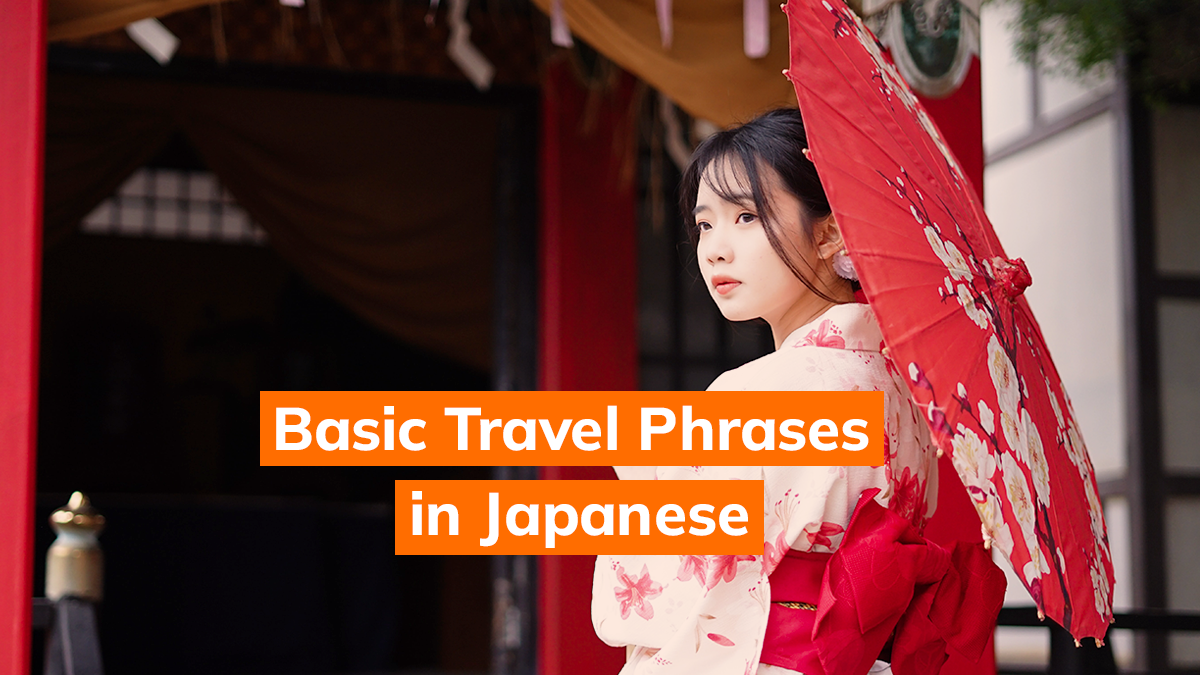
Useful Japanese Vocabulary For Tanabata Festival
Learning a few Japanese words can help you connect more deeply with the meaning and atmosphere of Tanabata. These terms capture everything from the mythical love story to the decorations, traditional clothing, and festive foods you will see at the festival.
Here is a helpful list to keep in mind if you want to understand what you hear and see during Tanabata.
| Japanese Word | Meaning |
|---|---|
| Tanabata (七夕) | The Star Festival itself |
| Orihime (織姫) | The Weaver Princess from the legend |
| Hikoboshi (彦星) | The Cowherd from the legend |
| Tanzaku (短冊) | Colorful paper strips for writing wishes |
| Bamboo (竹) | Bamboo branches used for Tanabata decorations |
| Sasa (笹) | Smaller bamboo leaves used in decorations |
| Kinchaku (巾着) | Small purse-shaped ornaments hung on bamboo |
| Kusudama (薬玉) | Decorative paper balls or flowers |
| Ondo (音頭) | Traditional festival dance and song |
| Nebuta (ねぶた) | Large lantern floats, similar to some Tanabata decorations |
| Hanabi (花火) | Fireworks, a highlight of summer festivals |
| Yukata (浴衣) | Lightweight cotton kimono worn at summer festivals |
| Matsuri (祭り) | The word for festival |
| Uchiwa (団扇) | Handheld festival fan |
| Yatai (屋台) | Festival food stalls |
| Omikuji (おみくじ) | Fortune slips often drawn at temples and festivals |
| Omamori (お守り) | Good luck charms sold at shrines |
| Shamisen (三味線) | Traditional Japanese stringed instrument sometimes played during festival performances |
| Happi (法被) | Light festival coats often worn by dancers or staff |
| Obon (お盆) | Another summer festival that sometimes overlaps with Tanabata traditions |
Knowing these words will help you spot decorations, understand performances, and even strike up simple conversations with locals. Bring this list along for a more meaningful festival experience!
Learn Real Japanese Through TV Shows With Lingopie!
Tanabata is a wonderful reminder of how wishes, traditions, and community come together in Japan every summer. From hanging colorful wishes on bamboo to watching lanterns glow and fireworks fill the night sky, this festival is a chance to feel the warmth of Japanese culture.
If this has inspired you to discover even more, learning Japanese is a great next step. Understanding the language helps you enjoy festivals, talk to locals, and appreciate stories like Tanabata on a deeper level. Lingopie makes it fun and simple to learn real Japanese through Japanese TV shows, anime, and movies.
Try Lingopie today and get ready to enjoy Japan even more on your next adventure.
Frequently Asked Questions
1. What is the Tanabata festival about?
The Tanabata festival celebrates the romantic legend of Orihime, the Weaver Princess, and Hikoboshi, the Cowherd Star. According to the myth, they are separated by the Milky Way and allowed to meet only once a year on the seventh day of the seventh lunar month.
2. What does Tanabata celebrate?
Tanabata celebrates the meeting of Orihime and Hikoboshi, symbolizing love, hope, and the reunification of loved ones. It's a time when people write their wishes on colorful paper strips (tanzaku) and hang them on bamboo branches, believing their wishes will come true.
3. Is Tanabata always on July 7?
Traditionally, Tanabata is celebrated on July 7th according to the lunar calendar. However, different regions in Japan may hold their festivals on various dates between July and August to accommodate local traditions and schedules.
4. What to do on Tanabata day?
On Tanabata day, people participate in various activities such as writing wishes on tanzaku, decorating bamboo branches with colorful ornaments, and enjoying festive parades and fireworks displays. It's also a time to appreciate traditional music and dances that celebrate the legend of Orihime and Hikoboshi.


